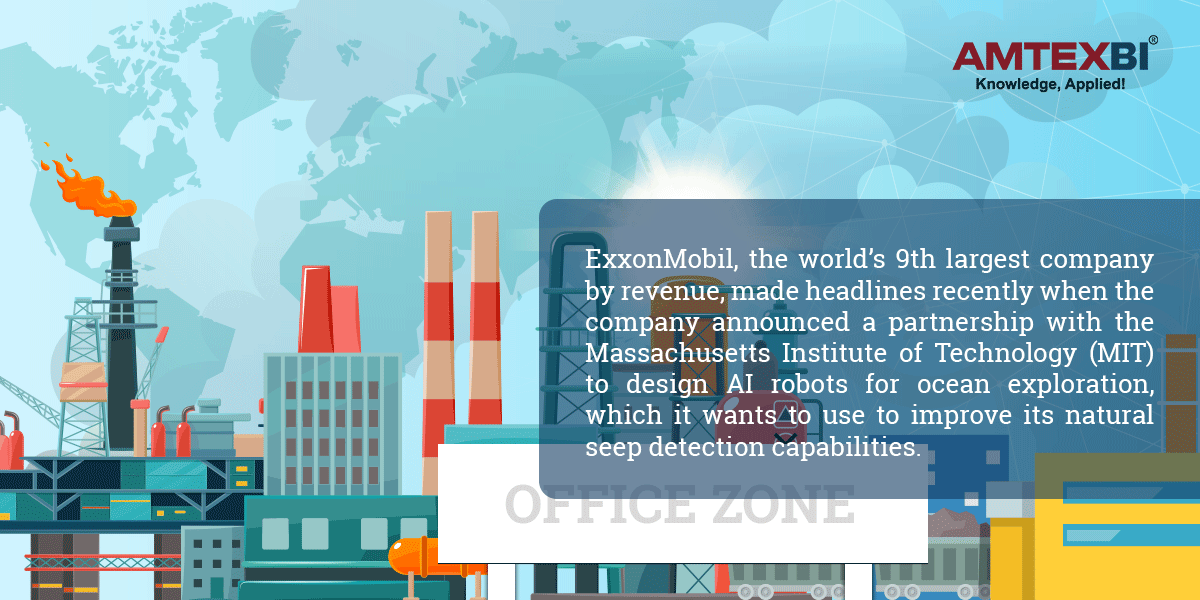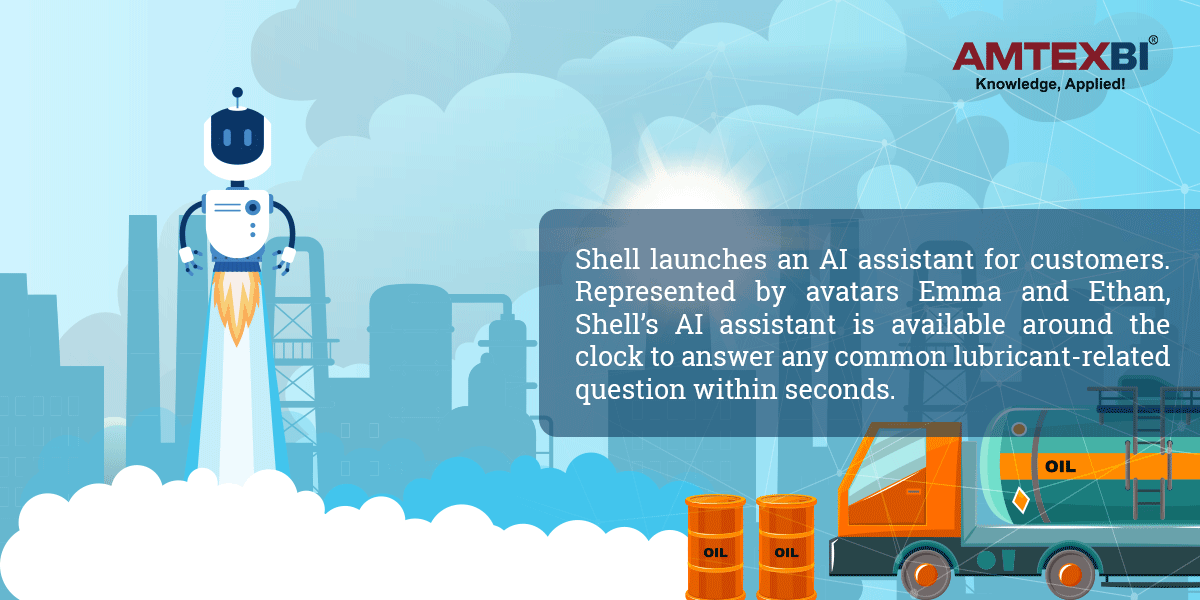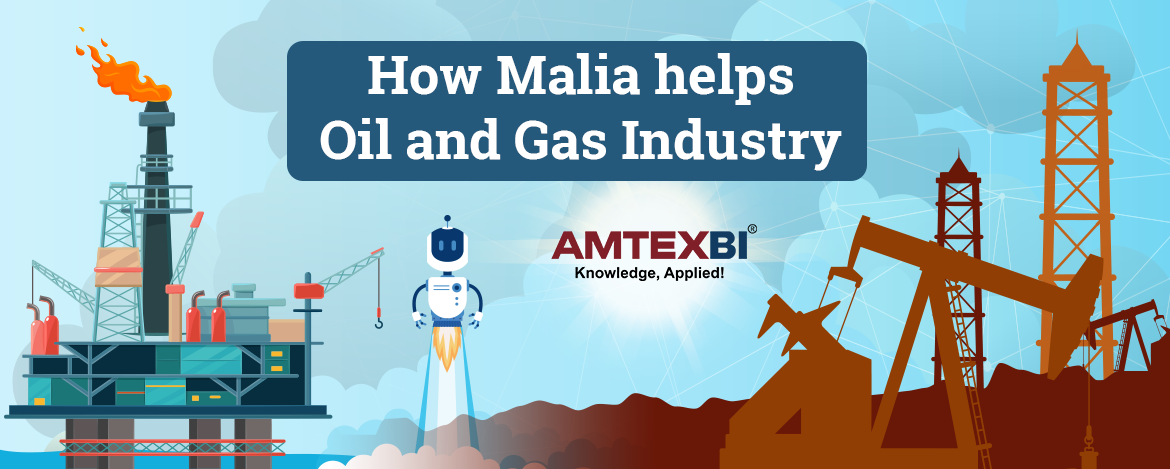How AI helps Oil and Gas Industry
Artificial Intelligence is the hulk of all technologies used across various industries; however,its role is slightly uncertain in the industries like Oil and Gas. There are facts that support digital technologies have always kept the costs in check and automating the business processes have long term benefits for the businesses.The latest technologies using sensors and satellites have given rise to huge data, which needs to be cleaned before it is used for insights. So far, use of AI and Big Data are just in theories and not an adopted practice.
Oil and Gas sector is generating massive amounts of data, what these companies need is a platform that can digest the large amount of data and give them the output in terms of real time responses in the best course of actions. More the historical data, more accurate will be the future predictions and Oil and Gas industry has tons of historical data.
AmtexBI illustrating how to leverage the capabilities of AI and ML!
Analytics is spread across the three categories of the oil and gas industry sectors: upstream, midstream, and downstream.
- Upstream involves the exploration and production side of the industry.
- Midstream usually refers to transportation and storage stages.
- Downstream involves the processes related to refining and selling oil.
Adopting AI in a complex business processes like Oil and Gas Industry is a challenging affair. However,stakeholders can see the potential use of AI in terms of extensive insights that will help them improve business outcomes.
This sector has huge potential, as most of the business actions are dependent on data from multiple sources, BI companies can help Oil Industry in data processing for relevant insights and with the help of AI they can drive business value in terms of:
- production optimization
- downtime minimization
- reservoir understanding and modeling
AI has the potential to bring efficiency in all the sectors of Oil and Gas Industry but, it is most promising during Exploration and Production as that is where majority of the resources goes in. However, before embracing AI at the upstream sector, the following questions should be considered:
- What AI capabilities are required to fulfill the need of this industry?
- How will AI benefit the upstream sector of the industry?
AI to Assess Oil Corrosion Risk
Corrosion by crude oil is a common risk for equipment failures in the oil and gas industry. Crude oil from oil fields usually varies in its chemical compositions and the corrosiveness of the crude also depends on the environment it is stored in.
The upstream companies need to store the crude oil in large tanks and transport the crude and refined oil through pipelines, predict the risk of corrosion using AI technology by using the historical data from the veteran engineers. The AI platform reportedly uses machine learning to analyze the data and identify factors that led to corrosion in previous situations.
AI as a Knowledge Platform
Veteran engineers used traditional maintenance techniques; they were the subject matter experts but with the rise in digitization the traditional methodologies were dissipated in the system generated alarms and maintenance schedules. For Oil and Gas industry AI can help in digitizing this knowledge from veterans and deliver it to the new engineers using a knowledge platform.
The platform will be a collective medium having knowledge of data, such as refinery incident reports and asset status, different types of crude that were collected by maintenance engineers over time which will be used in production times to make better decisions.
AI to Ascertain Risks Mitigation
Strategies
Global Oil and Gas companies have data at different locations and operate accordingly. For quick access of data records AI technologies are a savior, it helps in identifying the properties of crude and discover related risks based on historical records.
Use of AI will help companies in reducing maintenance costs, unplanned downtime and improving efficiency.
AI for Data Analytics
Exploration and production involves playing with lot of data such as well logs, fluid analysis, seismic surveys, static and flowing pressure stats, well production measurements,monthly production records of oil, gas and water and EOR fluids like CO2, steam,chemicals, gas.
Computer vision and natural language processing parts of AI can help digest data from these sources and give insights to support better decision-making regarding cost reduction during exploration and production processes.
AI for Analyzing the Seismic Data
Traditionally, seismic records collected by the companies were the image files that geologists analyzed manually, which was time-consuming.
Automation and AI techniques brought with it numerous benefits which include improved efficiency, drilling safety and better reservoir predictions by analyzing seismic data images. The 3D visualizations of the seismic data can give the list of equipment and parts in the production plant that are at high risk for failures. With latest technologies in place employees can prepare for contingencies and analyze the seismic data effectively without long manual computations.
Conclusion: Future of AI in Oil and Gas Industry

AI promises to boost the efficiency while keeping the cost in check and it is being flaunted as a knight in shining armor which will be the answer to all the problems. Its use is very nascent as compared to other industries but we can see the adoption is heading to maturity in the coming years. AI in this industry is not a program that is capable to make its own decisions; it’s mostly predictive analytics and machine learning.
Ren told Forbes’Mark Venables that “The biggest thing that will impact you as a company is that AI is going to go from theory to practice. So far it has been mostly theoretical, but people don’t understand how to do it and what it can do. I think now people understand its potential and more projects are being fulfilled and implemented. The infrastructure industry will start to push AI from the how, the technical, to the what, which means AI will be recognized by the problems it has solved instead of what data it collects.”
So far it has been mostly theoretical, but people don’t understand how to do it and what it can do. I think now people understand its potential and more projects are being fulfilled and implemented. The infrastructure industry will start to push AI from the how, the technical, to the what, which means AI will be recognized by the problems it has solved instead of what data it collects.”
This clearly points to the fact that, AI is seeping into the industry and that its capabilities are coming to surface gradually. In the coming years AI will be the integral part of Midstream and Downstream sectors of Oil and Gas Industry. As far as Machine Learning is concerned, it will grow using the historical data, and will help companies making more accurate future predictions.
AI Enabled Digital Assistants
If you think that digital assistants have not made a mark in this side of the world, its time you creep out from under the rock!


Meet Malia
A fully conversational digital assistant who uses natural language processing, machine learning, knowledge management and cognitive automation capabilities to give you precise,understandable and useful insights. The ability to provide quick response to the queries asked is one of the great features of MALIA. You can count on her,and she will be at your disposal to give you insights anytime, anywhere. Each interaction is saved in cache, for future reference and for quicker responses.Simply deploy Malia in your BI and Analytics environment and ask away. Malia eliminates friction by cutting the need to consult dashboards, reports and any such interface. If you previously had to pull out a report and scroll through charts and KPIs, Malia can now give you the answer in seconds.
Malia eliminates friction by cutting the need to consult dashboards, reports and any such interface. If you previously had to pull out a report and scroll through charts and KPIs, Malia can now give you the answer in seconds.






